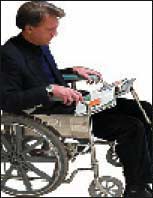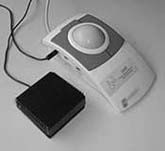Call 1-800-949-4ADA
for Technical Assistance
This document is also available as: PDF version and Microsoft Word version.
Coming to Terms with Technology
Overview
Many forms of technologies exist and have beneficial applications for students, including those with disabilities. Having a common vocabulary and an understanding of the purposes of these technologies can help school-based staff select, use, adapt, and monitor these types of technologies most appropriately.
Introduction
Throughout the evolution of technology, a number of terms have emerged to describe the different applications of technology in various disciplines. In the field of education alone, terms such as accessible information technology, assistive technology (AT), educational technology, electronic and information technology (E&IT), information technology (IT), and instructional technology are all found in the literature.
Although several of these terms are often used interchangeably in the educational
arena, subtle differences exist. This factsheet reviews five terms currently
used to describe the benefits of technology for students with disabilities:
information technology; adaptive equipment; assistive technology; electronic
and information technology; and the latest term to appear on the scene,
accessible information technology.
Information Technology
Information technology includes any product used to acquire, store, manipulate, or transmit information; this can include computers, multimedia, telecommunications, services (including support services), and related resources and equipment.
Within the educational setting, information technology may be confused with a variety of other terms such as adaptive equipment or assistive technology. While these may not be information technologies, they are all very much interconnected within the educational process; each is distinguished by its own application and resulting benefits.
Adaptive Equipment

© Adapt-A-Lap.
Inc.
Adaptive equipment is best described as any item, piece of equipment, or product system, whether acquired commercially, modified, or customized that is adapted to increase, maintain, or improve capacities of individuals with disabilities. Equipment is adapted to better meet a student's cognitive, sensory, or physical needs rather than the student adjusting to fit the device. Adaptive equipment allows people with certain limitations to improve, expand, and extend their capacity to interact with their environments and to function more independently.
Examples of adaptive equipment include:
- a reading aid device (see picture at right) for students who are unable to support books or magazines because of limited use of their hands, arms, or shoulders;
- an adjustable table for a computer station to accommodate students in wheelchairs;
- electronic switches used to drive a wheelchair for students with limited use of their hands and arms; and
- a switch-adapted mouse (see picture at right) for students with little or no fine motor control.
In the school setting, adaptive is often used interchangeably with the term assistive, or the two words are often combined into adaptive/assistive technology. Assistive technology is the umbrella under which adaptive technologies fall.
Assistive Technology

© RJ
Cooper
Assistive technology includes any piece of equipment or product system, whether acquired commercially, modified, or customized that increases, maintains, or improves functional capabilities of individuals with disabilities. Assistive technology includes both the devices and the services; for example, this may include a hearing test to fit a hearing aid or an assessment of students' needs related to IT.
As functional alternatives to standard operations, many assistive technologies serve as solutions designed to assist students in overcoming specific limitations. Because the majority of IT is designed for use by the general population and not specifically for individuals with disabilities, many assistive technology devices are developed after the fact to address accessibility issues. IT can be adapted and/or retrofitted with assistive technology on a case-by-case basis to meet the needs of each individual student. While IT can be thought of as universal, assistive technologies are more individualized. Assistive technology is not necessarily a high-tech device. For example, a pencil wrapped with tape to make it easier to hold for a student with limited muscle control is an example of a low-tech assistive technology device.
Examples of assistive technology include:

© Intellitools
- an alternative keyboard (see picture at right) for accessing a computer by students with physical, visual, and/or cognitive needs;
- hearing aids for students with a hearing loss;
- a speech synthesizer that voices words as they are entered on a keyboard by students with speech impairments; and
- a Braille notetaker (see picture at right) for students who are blind.

© PDI
Electronic and Information Technology (E&IT)
Electronic and information technology includes both information technology and equipment; it is an interconnected communications environment that consists of interactive, coordinated, interoperable, and networked information systems. In contrast to adaptive equipment and assistive technology, which are considered supplemental and compensatory, E&IT is best described as a built environment.
E&IT mediates access to and use of all types of information; it is specific to the environment of communications and information.
Examples of E&IT include:
- computers, software, and peripherals;
- video equipment and multimedia products that may be distributed on videotapes, CDs, DVDS, or the Internet;
- telecommunication equipment and products;
- office products such as photocopiers, fax machines, and calculators; and
- information kiosks (see picture at right), ATM machines, Web sites and other electronic resources.

© Montrgonet
Accessible Information Technology
In schools, the term accessible IT refers to IT used by either students or employees of educational entities that can be accessed and used in multiple ways.
When electronic and information technology provides only one way for users to gain access to or manipulate information, it is considered inaccessible. An example of inaccessibility is an automated or timed self-service transaction system that may not have delayed response time for individuals with limited hand control who may require additional cues or more time to select options via buttons on a touch sensitive screen.
If products and environments are to be accessed by users with a variety of abilities and disabilities, they need to be universally designed to be used without the need for adaptation.
Examples of accessible IT include:
- textbooks on CD-ROM and DVD that contain voice narration for students with visual impairments or cognitive disabilities;
- software tutorial programs that allow both use of the mouse and the keyboard by students with limited fine motor skills;
- accessible Web pages for students who use a variety of hardware configurations and software such as screen readers (viewable by as many browsers as possible, limited use of graphics, flow of text from left to right); and
- instructional software with voice narration, captioning, and sign language interpretation allowing students access to information through alternate formats.
Accessible IT involves much more than tools and access; it also encompasses an instructional philosophy that encourages a student-centered approach to learning. As an essential piece of the learning environment, accessible IT, if implemented correctly, is a means to increased and improved outcomes for all learners.
Similar to the concept of universal design, accessible IT is best considered during the design stage of the instructional process (such as during lesson planning). During this phase, careful thought can be given to how technology should be implemented and integrated into instruction.
For further reading, visit:
- AccessIT Frequently Asked Questions
Topics include: assistive technology, universal design, information technology, electronic and information technology, and accessibility. - Adaptive Devices
- Alliance for Technology Access
- Assistive Technology
- Assistive Technology Act of 1998
References
- AccessIT (2001). What is the Clinger-Cohen Act and how does it affect people with disabilities? Retrieved November 2004.
- AccessIT (2001). What is electronic and information technology? Retrieved November 2004.
- AccessIT (2001). What makes electronic and information technology inaccessible to people with disabilities? Retrieved November 2004.
- Bagley, C., & Hunter, B. (1992). Restructuring constructivism and technology: Forging a new relationship. Educational Technology, 32(7), 22-27.
- Boethel, M., & Dimock, V. K. (1999). Constructing knowledge with technology: A review of the literature. Austin, TX: Southwest Educational Development Laboratory.
- The Center for Universal Design (1997). Built environment overview. Retrieved November 2004.
- Jonassen, D. H. (1996). Computers in the classroom: Mindtools for critical thinking. Englewood Cliffs, NJ: Prentice-Hall.
- Mace, R. (1997).
What is universal design? The Center for Universal Design,
North Carolina State University. Retrieved June, 14, 2002 from
http://www.design.ncsu.edu:8120/cud/univ_design/ud.htm - Maddux, C. D., Johnson, D. L., & Willis, J. W. (1997). Educational computing: Learning with tomorrow's technologies (2nd ed.). Boston: Allyn and Bacon.
- National Institute on Disability and Rehabilitation Research (January 8, 2001). Notice of final funding priorities for fiscal years 2001-2002 for a National Center on Accessible Education-Based Information Technology and the Disability and Business Technical Assistance Center. Federal Register Online, 66(5), 1498-1506 (DOCID:fr08ja01-89). Retrieved November 2004.
- National Council on Disability (2001). The accessible future. Retrieved November 2004.
- Rice,
R. (1989). Federal
legislation and assistive technology. National
Information Center for Children and Youth with Disabilities News
Digest, #ND13, 6-7. Retrieved November 2004.


This factsheet was produced by the Southwest Educational Development Laboratory (SEDL) through a subcontract with the Southwest ADA Center. The Southwest ADA Center is a program of ILRU at TIRR in Houston, Texas. DLRP is one of 10 Disability and Business Technical Assistance Centers (DBTACs) funded by grant # H133D60012 provided by the Department of Education's National Institute on Disability and Rehabilitation Research (NIDRR). Neither NIDRR nor DLRP are enforcement entities.
Available in alternate formats upon request.
Copyright ©2005 The Institute for Rehabilitation Research (TIRR)
contact us: Southwest ADA Center
800-949-4232 or 713-520-0232 v/tty

